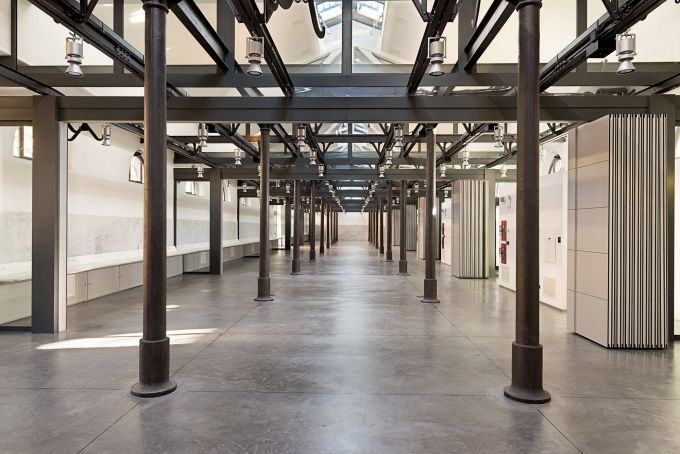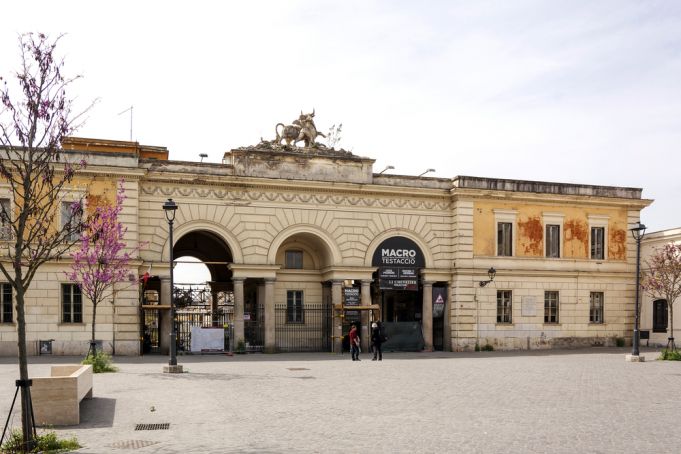“I don’t think we should be here,” Charlie says, glancing nervously at the monstrous brick buildings looming in front of us. Their shadows, cast by the weak yellow light of flickering street lamps, span across the cobblestone footpaths in front of us.
I understand his hesitation. This place, especially under the black night sky, looks the stuff of nightmares.
We are inside of the Testaccio Slaughterhouse, or “Ex Mattatoio,” as it is known to locals. Unbeknownst to tourists and international students, this retired industrial empire is a shortcut for getting back and forth between Testaccio and Trastevere, two of the Rome’s trendiest neighborhoods. We are on our way to dinner in Testaccio, the neighborhood famous for its award-winning restaurants and charcuteries.
“It’s fine,” I say, hoping my confidence will calm his uneasiness.
The only ghosts here are those of pigs and cows, and this is no Pet Sematary[1].
The first time I found this place, however, following my GPS to work, I was afraid I had stepped foot onto the set of a horror film.
Also read:
In stark contrast to the hustle and bustle of Trastevere, inside the rusted gates of the Ex Mattaoio, one finds themselves in a preserved bubble of history: a secret, abandoned world of identical tan buildings, connected by an extensive network of rusting, metal transportation beams.

In its glory days, the site was the source of cherished prosciutto, salami, speck, and any pork, sheep, or cow meat product that now stands as a staple of Roman cuisine. The district was a proud one, surviving on the scraps of their labors and creating from them their own working man’s cuisine.
The Tiber river, which conveniently runs just behind the slaughterhouse, was used to transport processed meat to wealthier areas of the city. With the utilization of new production and transportation methods came the fall of the Mattatoio, which became the Ex Mattatoio in 1975.
Charlie and I make our way through the narrow pathways, careful not to trip on loose cobblestones. As we walk, I point out the metal meat hooks above us. Once this place and its history are understood, it’s easy to imagine slabs of pork and veal hanging from them like decorations, swinging above busy workers in sterile white coats chopping and slicing with the organized exactitude of machine parts.
Also read:
Depending on which side of the Ex Mattatoio one enters, his or her first impression will vary drastically. The rear end of the slaughterhouse, where Charlie and I entered, remains abandoned. Each brick building has a handful of square, doorless entryways lining its face like blackened teeth. If one listens carefully, the sorrowful moans of a cello can often be heard.

The front entrance of Rome's ex Mattatoio. Ph: rarrarorro / Shutterstock.com
The front entrance, however, stands proudly in Piazza Orazio Giustiniani, grabbing the attention of any passersby.
Its monotonous tan visage is uplifted by the busy packs of students coming and going from the music school inside. Just inside, the slaughterhouse appears as an active, exclusive city: its retired buildings given new life in the form of classrooms and performance halls. Classical music echoes through the cobblestone pathways.
We stop briefly outside of a classroom to appreciate a lone violinist practicing a melody. The music school fits naturally into the former meat packing buildings, harmoniously blending the proud history of the past with the passion of the present.
Despite Testaccio’s fall as an industrial empire, the spirit of the slaughterhouse has never faltered. The thick scent of cured pork lingers in the air, ghostly reminiscent of its former glory. This is no illusion--meat remains an integral, almost intrinsic aspect of Testaccian values.
Former meatpacking buildings along the brick roads skirting the slaughterhouse have been converted to Testaccian trattorias, like the one we are headed towards. Their tall ceilings, seemingly decorated with retired meat hooks and transportation beams, pay homage to their roots.
Where in America, we would have bulldozed history in the name of renovation, the Ex Mattatoio holds tightly to its former self, standing as a testament to the Italian truth that the old can indeed live in harmony with the new.
Top photo: rarrarorro / Shutterstock.com
General Info
View on Map
The ex Mattatoio experience. Exploring Testaccio's slaughterhouse
Mattatoio, Piazza Orazio Giustiniani, Rome, Metropolitan City of Rome, Italy

















